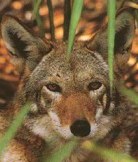 Wolves WolvesWolf History, Conservation, Ecology and Behavior
[www.wolfology.com]
|
The Wolf in Texas
Jason Manning
|
||
Texas used to be home to several subspecies of gray wolf. The Mexican gray wolf (Canis lupus baileyi) was once found in the western portion of the state. Canis lupus monstrabilis, the Texas gray wolf, occurred in central and south Texas, while the "buffalo" wolf, Canis lupus nubilis, followed the bison herds across the Staked Plains. A separate species, the red wolf (Canis rufus), once ranged throughout much of eastern and into central Texas. The buffalo wolf was extinct by 1926, the Texas gray wolf by 1942. (Wolf taxonomy was revised several years ago to reclassify twelve of the original subspecies occurring in the western United States and central Canada as C.l. nubilis; therefore, nubilis is not extinct according to that revision.) The last two wild Mexican wolves in Texas were killed in 1970, and by the late 1980s the Mexican wolf -- currently the most endangered of all the wolf subspecies -- was believed to be extinct in the wild. In the early 1970s there were so few red wolves remaining in a handful of southeastern Texas counties that they had begun to breed with coyotes. When the US Fish & Wildlife Service embarked on a program to save Canis rufus from extinction they could find only 17 red wolves sufficiently free of coyote DNA and therefore suitable for a captive breeding program's gene pool.
According to one theory, the first wolf-like mammal in the Northern Hemisphere originated in what is now Texas during the Pleistocene era, around one million years ago. About the size of today's coyote, it grew larger over time and spread northward, migrating into Eurasia via the Beringia land bridge, and there evolved into the progenitor of the gray wolf, which returned to North America by the same route 300,000 to 600,000 years ago. In the 20th century, Texas was one of the last of the wolf's strongholds as it was systematically eradicated from the lower 48 states. as Americans expanded westward they mercilessly persecuted the wolf, deeming it a dangerous creature that competed with them for game and threatened their livestock. "There are two species," wrote William Bollaert, who came to Texas in the early 19th century. "The large black wolf and the prairie wolf. They are hunted and shot. They destroy young cattle."
Texas was wolf country, and the wolf is very much a part of the Texas heritage. But today no wild wolves run free in the state. Bollaert described the traditional approach to wolves that was already centuries old when he wrote those words; it was an approach that continued to rule the day until fairly recently. Now the wolf is making a comeback, and a strong majority of Americans support wolf recovery. One day soon the wolf will come home to Texas.
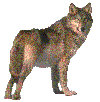 Like most Native Americans, the Tonkawas of central Texas admired and coexisted with the wolf. They believed that a terrible fate would befall anyone who killed a wolf, because it was the wolf who had brought man into the world. In the 1850s, Colonel Randolph B. Marcy visited Texas to make surveys for Indian reservations, and r eported on a Tonkawa ritual called the Wolf Dance. Fifty warriors dressed in wolf skins entered a large "dance lodge" on all fours, perfectly imitating the behavior of wolves. They sniffed the earth and at length began to dig, exhuming another warrior who had been previously buried below the surface, and who played the role of the first man on earth. The warrior, acting out his part, protested being brought from the spirit world where his every need had been attended to. A council of older wolves discussed what was to be done with him and decided that he should remain on earth and become a hunter.
Early white settlers had their own wolf legends. In 1834 an English colony was established near the Rio Grande on a grant given Dr. John Charles Beales by the Republic of Mexico. One member of the colony was George Dent, a loner who made his living as a trapper along the Devil's River. Dent was married, and his pregnant wife went into labor when they were far removed from the colony. Leaving his wife, who was unable to travel, Dent rode for help. He found a Mexican sheepherder, who agreed to accompany the trapper back to his camp, and brought along his own wife to assist in the birthing. Arriving at the camp, they found Dent's wife dead from childbirth. The newborn was gone, and wolf tracks were seen. Dent assumed his infant was also dead.
Years passed, and then came reports of a girl seen running with a wolf pack. Seminole scouts stationed at a nearby military post were sent to investigate and found small human footprints mingled with wolf sign. A search party tracked down the pack and captured the girl. Wild and uncontrollable, she was locked in a shed while the men debated what was to be done with her. In the night the wolves came and attacked the men's horses. This, however, was only a diversion; assisted by the wolves, the girl loosened a plank in the shed wall and escaped. For 50 years there were occasional sightings of the Wolf Girl of Devil's River. Or so they say.
Wolves followed the great bison herds in all seasons, day and night, preying on stragglers. Occasionally they attacked wild horses. The mustangs would form a circle and battle with teeth and hooves; if they ran the wolves would give chase and sometimes succeed in bringing down a horse. in 1855 Alexander Ross wrote in his book The Fur Hunters of the Far West how usually only two wolves initially approached a horse, while the rest of the pack hung back. The pair of wolves behaved "in the most playful manner, lying, rolling and frisking about until the too credulous victim is completely put off his guard by curiosity." Suddenly, the wolves attacked, one springing at the mustang's throat, the other at its hindquarters. As the horse fell, the rest of the pack rushed in to finish it off.
After the Civil War wolf skins were of some value, bringing a dollar or two apiece, and hundreds of men made a living as professional wolf hunters, or "wolfers." Finding the wolf was easy. All one had to do was find the bison. The wolfer would kill a buffalo, make cuts in the carcass with his knife, and pour strychnine into the cuts. A poisoned carcass could claim as many as 100 wolves and coyotes. An industrious wolfer could earn several thousand dollars per annum. In Texas, wolfers frequented the Staked Plains, where the buffalo roamed.
William Banta, a buffalo hunter who later became a Texas Ranger, often encountered wolves on the Llano Estacado. In his book Twenty Seven Years on the Texas Frontier, Banta wrote of an incident in which a member of his hunting party turned up missing in the dead of winter. Banta and his companions searched for the missing man, and finally found him far from camp and afoot. The man explained that he had killed a buffalo and skinned it, but when the weather turned bad he rolled up in the green hide to avoid freezing to death. Wolves came to feed on the buffalo carcass, and some began chewing the hide in which the man had wrapped himself. The hide had frozen stiff, and the man could not move. "When it came day," Banta reports the man as saying, "and when they began to grit their teeth near my head, I fairly trembled with fear, and could not help saying 'suy'. The wolves would look around, and not seeing anything, would begin to eat on the frozen hide so close to my head I could almost feel their teeth clipping my ears." Eventually the wolves went away, the sun warmed the hide, and the man got free -- only to find that his horse had frozen to death.
By the 1870s the bison herds had been decimated by buffalo hunters, who were encouraged by General Phil Sheridan to continue their work until every last "shaggy" was dead. In this way the "Indian problem" could be resolved, since the Plains tribes depended on the bison for survival. When the Texas legislature considered a bill to protect the bison, Sheridan advised against it. "Let them kill, skin and sell until the buffalo are exterminated," he said. "Then your prairies can be convered with speckled cattle." The killing and skinning and selling continued, and by 1878 the Texas bison herds were no more. After men like Banta and his companions had wiped out the buffalo, the wolves were forced to find new prey. Out of necessity they turned their attention to Sheridan's "speckled cattle."
The Texas longhorn was capable of defending itself from predators. When wolves moved in, longhorns formed a protective circle around heir calves. The cry of a calf or cow beset by wolves would bring other longhorns converging on the scene with, as one observer noted, "wild and angry" looks. Bulls locked in combat might attract an audience of wolves, who would sit by and watch the proceedings in hopes that the loser might be so injured that it became easy prey. It wasn't until stockmen introduced Herefords onto the open range in Texas that the real problems with wolf predation began. Unlike the longhorn, the Hereford was no match for a wolf pack.
"Of all predators which prey upon our herds and flocks," wrote Judge O.W. Williams of Pecos County in 1908, "the lobo inflicts the most damage, and causes stockmen the most trouble." In fact, summer droughts and winter blizzards caused more livestock losses than wolves, but cattlemen couldn't control the weather. They could control wolves, though, and set about doing so with vigor, experimenting with a variety of methods. Cattle baron Charles Goodnight's wife Mary, in discussing life on the Goodnight Ranch for an article appearing in a 1901 issue of The Ladies Home Journal wrote, "We have deer and antelope, and did have wolves, taming the latter with the idea that we might employ them to decoy [their] wild brethren within gunshot; but the domesticated ones became such a nuisance that we killed them." (Mary Goodnight would not be the last person to discover that you could not "tame" a wolf.) Other ranchers used wolfhounds. So did a Texas Ranger named Tannerey, who claimed his dogs killed many a wolf in the Texas Panhandle. Tannerey's wolfhounds, however, proved no match for one of the most famous of the outlaw wolves -- Lobo, the King of Currumpaw, who for many years frustrated every attempt made by ranchers in northern New Mexico to end his career. Tannerey boasted that he would take Lobo's scalp, and set out to find the outlaw's pack. Find them he did, and turned his wolfhounds loose. Lobo and his followers separated, forcing the dogs to split up, too. When the wolves reunited, some of the dogs were running behind, and the wolves led by Lobo turned on the others and killed or severely injured the hounds. Tannerey gave up his quest shortly thereafter.
Texas had its share of famous outlaw wolves. In the 1920s the White Lobo frustrated every attempt by wolfers to trap her. Montie Wallace, foreman of the Downie Ranch in Pecos County, decided to try collecting the $500 bounty on the White Lobo's head. "I trapped and trapped," said Wallace. "I could never understand why I had no success in catching the white wolf." One day Wallace was riding in a canyon when the White Lobo suddenly stood up less than thirty feet away. The cowboy figured that the wolf was deaf or it would have heard him approach and slipped away unseen. Wallace dismounted and fired his rifle twice. The first bullet killed the White Lobo, but it took the second bullet, insisted the foreman, to knock her down. Not only was she deaf but she had no sense of smell, either. That was why Wallace had been unable to lure her with his baited traps.
On the XIT ranch, 150,000 head of cattle grazed a three million-acre range, and the ranch owners paid a bounty of $5 to $10 to cowboys who succeeded in killing a wolf. Some hands were given wolf-hunting assignments during the winter months. Ranchers calculated that a wolf killed about 75 head of cattle a year. Wolves quickly learned not to return to a kill for a second feeding, as they would have done under normal circumstances. Cowboys carried bottles of strychnine in their saddlebags, with which they laced any cow carcasses they discovered, in hopes that the wolves would come back until every bit of meat had been stripped from the bones. As a result, wolves modigfied their behavior and ate only from fresh kills -- bringing down far more cattle than they would have otherwise.
The XIT cowboys often tried to ride the wolves down. They knew that for the first few miles of the chase a wolf could easily outrun a horse, so the cowboys settled their mounts down into a "long lope," keeping the wolf moving until it tired. These pursuits sometimes lasted 10 or 15 miles. In one instance, a cowboy had to chase a wolf 25 miles. At the end of the chase the cowboy would either shoot the wolf or rope it and drag it to death. They also searched for dens in the early spring, killing all the pups of any litter they found. In this way the XIT men accounted for about 200 wolves in the late 1890s, and killed the last wolf on the ranch in 1916.
Public and private bounties ranging from $10 to $50 were a factor in significantly reducing gray wolf numbers in Texas by 1905. Increasingly, attention was turned to the red wolf. Vernon Bailey, who worked for the U.S. Biological Service (USBS) to determine the best way to eradicate the wolf, reported in 1907 that few people attempted to raise sheep in east Texas because there were too many wolves. (Ironically, the Mexican gray wolf, C.l. baileyi, is named for Bailey.) In a 1915 U.S.Senate debate on funding wolf control projects, it was reported that the state of Texas paid $88,930 in bounties in one year. That didn't include bounties paid by counties and livestock associations. The 1920 USBS annual report stated that the "wolf situation is one that will require intensive organized effort until the last animal is taken" in a number of states, including Texas. By 1928 the USBS had 500 men doing predator control in nine districts, one of which was Texas.
While Arizona and New Mexico relied on state and federal wolf control, Texas depended to a large extent on local control. In 1926, Brewster County hired W.P. Williams to trap wolves from March to June and paid him $50 a month for his trouble. Williams managed to account for three of six wolves known to be in the southern part of the county. A Pecos County ledger entry from this period reveals that $5 was paid for one "lobo wolf," $10 for two "gray/timber wolves," and $4 paid for each of four "coyote wolves." A trapper (in this case paid by the state) captured and killed 350 red wolves in Refugio County between 1938 and 1941.
There is some debate as to exactly when the last gray wolf of Texas origin was killed. Two Mexican grays were taken in 1970, but they are believed to have come across the border; one was a two-year-old male slain by a deer hunter in Brewster County's Cathedral Mountains, while the other was found dead in a trap near the juncture of Brewster, Terrell and Pecos counties. It is widely believed that the last "native" Texas gray was killed in 1942 in Presidio County by a man named Nelson Elliot. The war against the wolf in Texas was over. Only a handful of red wolves remained in the swamps and thickets of southeast Texas, and in the 1970s they were rescued by the U.S. Fish & Wildlife Service (FWS) and made part of a captive breeding program. After that there were no wild wolves left in Texas.
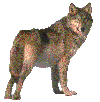 When the U.S. Congress passed the Endangered Species Act (ESA) in 1973, the red wolf was one of the first species listed. The FWS had already begun a red wolf recovery program to save the species from extinction caused by "hybrid swarm" -- the loss of genetic integrity due to hybridization, in this case between red wolves and coyotes. (A Texas biology professor, Howard Carley, is credited with bringing this threat to the attention of the public.) Because the ESA initially mandated saving the red wolf in the wild, the FWS tried to create a buffer zone around the last remaining red wolf habitat, in which federally-employed trappers would remove all coyotes and hybrids. This turned out to be impossible.
The only recourse was removal. Of the 43 "pure" red wolves extracted from the wild, some -- after further testing -- turned out to be hybrids and had to be destroyed. Others died of disease. In the end there were only 14, but by 1992 that dangerously small number had grown to 200. Red wolf reintroduction was attempted in the Great Smoky Mountains National Park and North Carolina's Alligator River National Wildlife Refuge. The program failed in the Smokies due to high pup mortality. Begun in 1987, the Alligator River project succeeded with about 80 wolves currently in the wild. The FWS is looking for other sites where the red wolf can be reintroduced. Some believe that east Texas, where the red wolf made its last stand, should be one of them.
In 1977, wolf trapper Roy T. McBride was hired by the FWS to live-trap any Mexican grays he could find. The federal government was about to embark on a mission to rescue the Mexican gray wolf -- the most endangered wolf subspecies in the world -- from extinction. McBride could locate only five individuals, all of them in northern Mexico. Four of these formed the basis for the Mexican Gray Wolf Captive Breeding Program. (Some people believe a few wild lobos remain in the rugged Sierra Madre, once the hideout of Apache renegades like Geronimo.)
Ten years later the FWS was prepared to reintroduce the Mexican wolf into the wild. One of the sites under serious consideration was Big Bend National Park in Texas. Approximately 35% of the 1,200 square mile Big Bend NP and the nearby 400 square mile Big Bend Ranch State Park was deemed prime wolf habitat. But the State of Texas refused to cooperate in the matter of Mexican wolf reintroduction. Unlike New Mexico, Texas had no cooperative agreement with the FWS to promote the recovery of endangered species. The anti-wolf contingent argued that Big Bend NP did not contain an adequate prey base to keep wolves within the park's bundaries; in truth, there were plenty of whitetail deer, mule deer, and javelinas to support a number of wolves. In a 1988 response to a letter by Rick Lobello, a biologist and director of the Big Bend National Park's Natural History Association, Texas Parks & Wildlife Executive Director Charles Travis claimed that a state law (63.102) prohibited wolf reintroduction. The FWS did not force the issue and looked elsewhere, reintroducing Mexican wolves into the Apache-Sitgreaves National Forest in eastern Arizona. According to Bruce Hampton in his book The Great American Wolf, "Texas, whose state wildlife agency had long sided with agricultural interests opposed to recovery, was completely out of the picture." Hampton claimed that state wildlife agencies in Texas and elsewhere were largely funded by sports hunters, who also opposed wolf recovery.
In 1990 the news broke that a huge 2.5 million acre international park that would join Big Bend NP with parts of the Mexican states of Coahuila and Chihuahua was being discussed. This rekindled hopes for future Mexican wolf reintroduction in Texas, as the park would contain plenty of suitable habitat, not to mention a more-than-adequate prey base -- to sustain a population of wolves. There was a certain irony in the idea that wolves would one day be able to cross back and forth between the American and Mexican portions of such a park; a century earlier, Texas ranchers had advocated a "wolf-proof" fence along the border to keep out wolves from Mexico.
In 1989, Dr. Jane Packard, who had studied Arctic wolves with wolf biologist Dave Mech, taught a well-received seminar on wolf ecology at Texas A&M University. In 1992, Texas Governor Ann Richards spoke favorably of wolf restoration in the state while a chief scientist for the National Park Service told the Dallas Times Herald that wolf reintroduction into Big Bend had a 99% chance of working. According to Rick Lobello, returning the Mexican wolf to Big Bend "could help bring the park into ecological balance for the first time in over seventy years." Some ranchers in the area privately conceded that the return of the wolf would enhance land values -- not to mention the ranching industry's public image. They realized (as had the Arizona Cattle Growers Association when it adopted resolutions favoring Mexican wolf reintroduction) that being anti-wolf was to be on the wrong side of a high-profile environmental issue. Yet laws like 63.102 (see below) stayed on the books in Texas, and the Texas Parks & Wildlife Department remained, at best, indifferent to wolf recovery. As a consequence, the Texas ecosystem is still missing a vital element, and a Texas native -- the wolf -- has yet to be welcomed home.
The state flower of Texas is the "wolf flower" -- otherwise known as the bluebonnet.
TEXAS HAS THE POTENTIAL TO BECOME THE ONLY STATE TO HOST WILD POPULATIONS OF BOTH SPECIES OF NORTH AMERICAN WOLVES, CANIS LUPUS AND CANIS RUFUS.
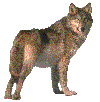
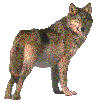 In the Old Days
(The following are excerpts from interviews of Texas residents taken as part of the Federal Writers' Project, 1936-1940. They provide insights into attitudes of people in those days towards the wolf)
"When I was a kid 14 years oldf I worked for Jim. He was an old wolf and buffalo hunter. Sixteen of us left Fort Griffin in December, 1872. Well, we got on our way and olf Jim Reed gave the order. He said, 'Boys, we are going out and camp, and poison wolves that herd the buffalo. There will be great rascals, old blue loafers and white loafers.' We found seven buffaloes that were down; the wolves had eaten parts of each and one was still alive. We took his heart, cut it up and put poison all over it and the remains of the other buffaloes. The next morning when we got up we had 46 dead wolves. Old Reed came over from their camp bragging about his outfit killing 41 wolves but when we told him our luck he shut up. About a thousand old loafers would surround the buffaloes and keep them going around and around for a day or so until the buffaloes broke to run for rest, food or water, then the wolves would devour the younger ones."
-- W.M. Dickson
"Hunting wolves was one of our pass-times. When we had time we would hunt wolves and bet on each others hound. These hounds knew the wolf business and I have seen some pert fights. No one hound would be able to best a lobo, but two or more would team up on one. While one dog was after the wolf from one side a hound would come in from the opposite side and in that method would slash the wolf until it was down. Quite often we would shoot the wolf before the fight was over to save the dogs, but not until after wolf was about in. We wanted to see all the scrapping we could."
-- Avery Barrow
"Mr. Merry worked for the T-Anchor ranch under the management of John Hudson, an Englishman. Mr. Hudson, with the knowledge of the work of hounds in the English countryside, brought a number of them to the plains to rid the ranch of wolves which were making inroads on the cattle. A man named Poston was placed in charge of the dogs. Once, tiring of the arduous duty, he left for town. Upon returning to his charges he found that wolves had devoured the chained hounds. [A]sked what he was going to say when he made his report to the manager, [he] spat disdainfully and drawled, 'Anyway, I've done something better than catch wolves. I have got rid of some of them damn dogs.' Mr. Merry had numerous encounters with wolves. The big lobo, or "loafer" wolf, was canny and hard to catch. The ranch had a bounty of $10 on a lobo scalp and also maintained the hounds to help in exterminating the wolves and coyotes of the canyons. One day, riding the rim of the canyon, he saw a mother wolf with several pups ambling along the precarious wall beneath him. His approach alarmed the old wolf and she quickly sped into the distance before he could have shot her, even if he had had a gun with him. Dismounting, he picked up rocks from the canyon rim and attempted to kill the lobo pups. The little wolves looked up at him with quick, bright eyes, dodging the rocks neatly at each throw. A stone dislodged accidentally from the rim fell upon the head of one of the little fellows and he ran whining with pain into a small opening in the canyon wall, the others following him into the shelter. After the pups had gone into the hole, Mr. Merry climbed down to the spot and filled the opening with dirt and stones to keep them safe until he could go back to camp and bring back a wagon. Returning with the wagon and team, he cut an eight-foot cedar pole...and attached it to a shovel which he bent in the shape of a hoe. With this contraption he raked away the obstructing dirt and twisted the little wolves out of their hiding place. The opening was too small for him to enter, but he did crawl part of the way into the 20-foot deep aperture to get the last of the 14 pups, one of which got away later. he took the wolves to Hudson and asked for the bounty on the 13 scalps."
-- S.P. Merry
"Prior to going to the river, I had mixed some wolf bait, there was a bounty paid for wolf scalps and I was intending to place the bait along the river. The bait was a mixture of flour and strychnine stirred in water making a paste. That was left in a pan at the camp and when Laughing Smily and his braves saw the mixed flour, which they no doubt took for flap-jack batter, they filled their flue with the mixture. When we returned to camp we found 13 moaning Indians and in a short time there was 13 good Indians which became wolf food. That is how Chief Laughing Smily met his death."
-- George L. Flanders
"We all went to bed and were just about asleep when we heard coyotes and wolves howling and snarling some distance from our camp and they kept us up all night. We could not make out what they were after for we knew that they were not after our horses. Early the next morning father got up and walked out in the direction from where we had heard the wolves and coyotes and found that they had been digging in a new made grave. he called to the other men to come and help him fill in the grave as the wolves and coyotes had dug down to the coffin. There was a small board with the name 'Lillie Walker Age 16 years' which they put at the head of the grave."
-- Edith L. Crawford
"The two oldest boys would have to go across from home to Red Bluffs on Red Creek to drive the milk cows home. The wolves used to get after them. I remember one time the boys were coming along home with [our watch dog] Old Bull. When the wolves would get too close Bull would chase them away. The boys thought it funny but it wasn't to me."
-- Nellie B. Cox
"I was driving along in a pretty fast gait when I caught a glimpse of something white and yellow. It was a big lobo wolf, standing a couple of hundred yards from the road. He had his head up and was facing east. That was as pretty [a] sight as ever I saw in the Plains country."
-- Judge P.F. Brown
|
||
Copyright 2003 Jason Manning All Rights Reserved
Feel free to duplicate for educational purposes.
|
